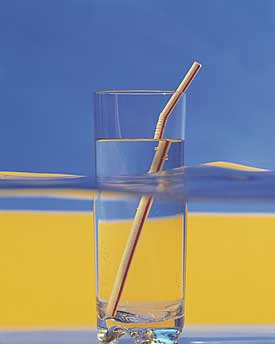Interview with Pete McArthur
Pete McArthur has been one of the most prominent commercial & advertising photographers in the field for quite some time. His images are highly conceptual and he's developed a look and feel that is uniquely his. He's also started his own stock photo division. We chatted via e-mail recently.

KW: How about a basic one minute bio to start?


KW: How about a basic one minute bio to start?
PM: I was originally trained as a graphic designer and later switched to photography just to avoid working with type frankly. I graduated from the Art Center in Pasadena in 1982 and by some twist of fate have wound up teaching there part time for the past 15 years which has been a wonderful compliment to my usual studio work.KW: Who were your early influences?
Bio as follows:
Kendall School of Design/ Advertising. Art Center College of Design/ BFA Photography. Illustrative still life photographer, Pete McArthur Visual Art Services, Culver City. Clients include: Kohler, Xerox, IBM, Microsoft, Sylvania, Corona, Knudsen, Wells Fargo, Honda, Nissan, ATT, Capitol Records and Kodak. Awards: Communication Arts, Print and American Photographer, AIGA/Los Angeles. Organizations: Past board member and current member of The Advertising Photographers of America, L.A. chapter and member of The Picture Archive Council of America (PACA).
PM: My earliest influences were actually painters. Wayne Thiebaud and Paul Wonner in particular played a big role in the early stages of developing my style. Through the years I've borrowed from others like Picasso, Warhol, Vasarely and even some of the Dutch still life guys from the 1600's. I think if you look at my body of work as a whole however, you'll keep seeing my personality and individual point of view running through most of it even with these other underlying influences.KW: How about now?
PM: I'm still very interested in what some of the realist painters are doing but have become more aware of a need or craving on my part to demonstrate some of the things photography does best like revealing "truth" and in turn fooling the eye. One photographer I've been following through the years is John Phfal. I think he has the most elegant point of view in the medium I've ever seen.KW: Has your approach to your art changed much over the years?
PM: Yes, I guess in some respects you'd have to say I'm more a product of commercial influences rather than art. What I've come to understand is that as commercial photographer I've worked very hard to make images for others and my success or failure rests with the client's opinion of the outcome. At the same time, I've always been rewarded for my particular contribution within each project and it has been this input (sometimes conceptual, sometimes graphic, sometimes just outright problem solving) that has been the constant in my work. Most of it has been collaborative and that's the way I really work best.KW: What is your creative process? Walk us how your work out ideas for an assignment.
PM: It varies depending on whether I'm working in advertising, design or editorial. In advertising, the concept is usually already worked out and in most cases the visual is right there too. My contribution is more in terms of rendering and composition.KW: You mention lots of paper and pencils and being tactile, has technology affected the way you work?
For the design and especially editorial projects, I'm responsible for the conceptual direction of the images as well as tying them all together in a nice looking package.
I usually get some kind of manuscript and if possible a headline in editorial, in design it's usually a rough layout of the piece and the key image points for each shot. After a 10 to 20 minute conversation with the AD I'll take the notes and layouts and start outlining concepts and noodeling thumbnails in my sketchbook until some of it starts making sense. I find Roget's Thesaurus very helpful in dredging up visual clues from the various keywords in the project. I'm big on paper, scissors, Xerox copies, color pencils and tape. I need those sounds and smells to keep me excited and to keep things fluid and tactile.
I usually present three different directions in thumbnail form, just B&W line drawings. The art director and I refine these with feedback from their CD, editor or client and then a set of color final comps are presented before going into production. It the same model used in advertising and while some may think it a little stiff or limiting, it really gives all of the parties involved a stake in the final images.
PM: I think it's really helped me as far as saving time filing, retouching and made communications easier and faster. As far as creativity, I don't think it's effected me as much as one would think.KW: Do you build much of the sets and props for your images?
PM: Yes, I have a shop for fabricating much of the props and sets, which I either make myself or engage the help of an assistant on larger projects. My model making abilities do have limitations and for the occasions where we need some special prop or large set, I'll just hire it out.KW: Is there someone from outside photography that has influenced you creatively?
PM: Outside of the painters I mentioned earlier, my biggest influence was my parent's encouragement in my earliest creative pursuits. From the darkroom in the basement, the silk-screening and airbrushed t-shirt years, and bumping from one art school to another, if it wasn't for them I'd just be another draftsman sitting in front of a CAD program. Photography would have stayed a hobby.KW: What is your most effective creative environment?
PM: Being partnered with an enthusiastic and talented designer, confronted with a challenging visual problem and being supported by an understanding client with a reasonable deadline and lots of money. Seeing as how this has only happened six times in my entire career, I'd settle for just the enthusiastic designer.KW: You took the stock image issue head on by creating your own stock library. I know many shooters have felt a pinch from the current glut of cheap stock images. What do you see as the future when it comes to stock vs. assignment?
PM: On the future of stock vs assignment: I don't look at the trend as having to be mutually exclusive. One thing that has worked well for me has been by actively operating my own stock business; it has allowed me to stay in touch with clients that would have otherwise been dealing with a stock agency on a regular basis rather than myself. This keeps me in-touch with their needs, buying habits and also leads to combining sales of stock images with assignment shots. I'm also much more knowledgeable about my own library than any stock house sales rep. The difference is this: I think of the designers who use my work as clients buying a service as opposed to a stock agency treating them more as customers buying products.
From here forward, the big question for me is: With the trend in image buying tilting heavily towards shopping rather than directing photo shoots, can I continue to convince designers that creating new images from scratch is just as cost effective and just as convenient as trying to pull together eclectic collections of existing stock images and trying to work them backwards into concepts while at the same time trying to make the edited group look as though they all have a common point of view. I have the most fun and get the greatest satisfaction working with these talented people in a creative capacity.
